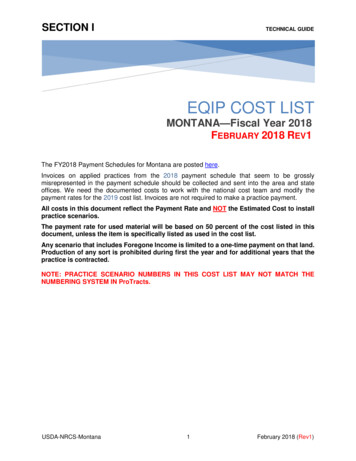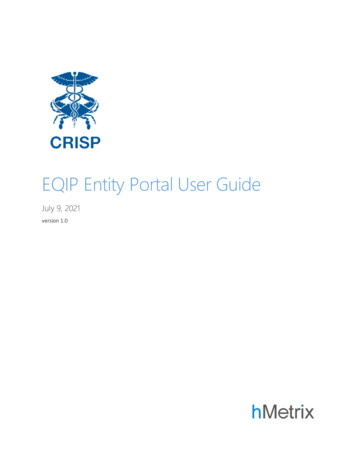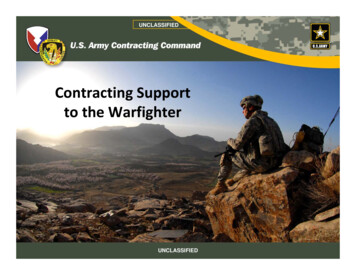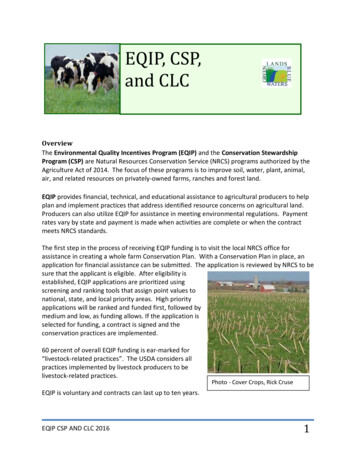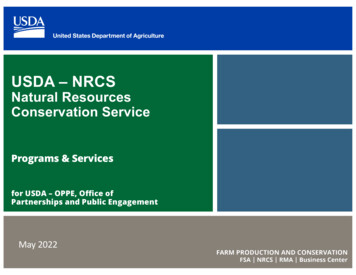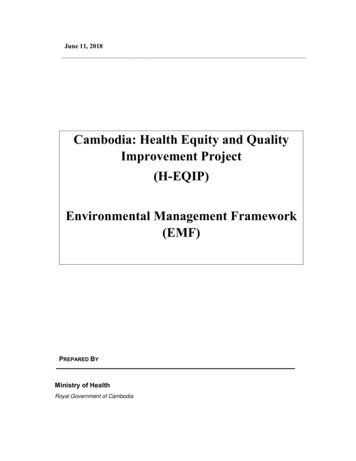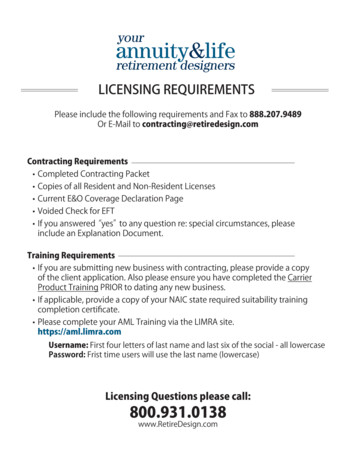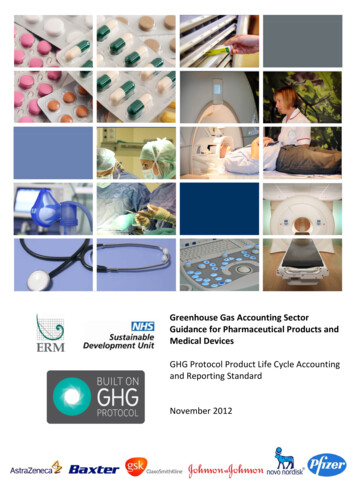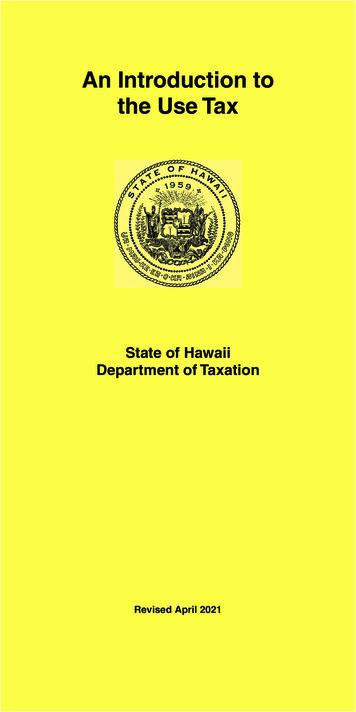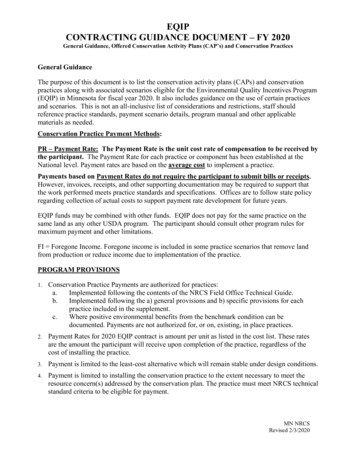
Transcription
EQIPCONTRACTING GUIDANCE DOCUMENT – FY 2020General Guidance, Offered Conservation Activity Plans (CAP’s) and Conservation PracticesGeneral GuidanceThe purpose of this document is to list the conservation activity plans (CAPs) and conservationpractices along with associated scenarios eligible for the Environmental Quality Incentives Program(EQIP) in Minnesota for fiscal year 2020. It also includes guidance on the use of certain practicesand scenarios. This is not an all-inclusive list of considerations and restrictions, staff shouldreference practice standards, payment scenario details, program manual and other applicablematerials as needed.Conservation Practice Payment Methods:PR – Payment Rate: The Payment Rate is the unit cost rate of compensation to be received bythe participant. The Payment Rate for each practice or component has been established at theNational level. Payment rates are based on the average cost to implement a practice.Payments based on Payment Rates do not require the participant to submit bills or receipts.However, invoices, receipts, and other supporting documentation may be required to support thatthe work performed meets practice standards and specifications. Offices are to follow state policyregarding collection of actual costs to support payment rate development for future years.EQIP funds may be combined with other funds. EQIP does not pay for the same practice on thesame land as any other USDA program. The participant should consult other program rules formaximum payment and other limitations.FI Foregone Income. Foregone income is included in some practice scenarios that remove landfrom production or reduce income due to implementation of the practice.PROGRAM PROVISIONS1.Conservation Practice Payments are authorized for practices:a.Implemented following the contents of the NRCS Field Office Technical Guide.b.Implemented following the a) general provisions and b) specific provisions for eachpractice included in the supplement.c.Where positive environmental benefits from the benchmark condition can bedocumented. Payments are not authorized for, or on, existing, in place practices.2.Payment Rates for 2020 EQIP contract is amount per unit as listed in the cost list. These ratesare the amount the participant will receive upon completion of the practice, regardless of thecost of installing the practice.3.Payment is limited to the least-cost alternative which will remain stable under design conditions.4.Payment is limited to installing the conservation practice to the extent necessary to meet theresource concern(s) addressed by the conservation plan. The practice must meet NRCS technicalstandard criteria to be eligible for payment.MN NRCSRevised 2/3/2020
EQIPCONTRACTING GUIDANCE DOCUMENT – FY 2020General Guidance, Offered Conservation Activity Plans (CAP’s) and Conservation Practices5.The practice scenario selected should be the best technical match for what is beinginstalled/implemented under that technical standard. Scenario selection shall not be based on thepayment rate.6.For certified Historically Underserved (HU) participants, the payment rate will be HUP rateshown in the cost list. For participants who certify as a Historically Underservedparticipant, field staff MUST select the HUP component in the cost list. Checking theLimited Resource, Beginning Farmer, Socially Disadvantaged Farmer or Veteran Farmer (alongwith additional requirements) in the ProTracts application will not automatically result in ahigher payment rate.7.The foregone income scenarios can be contracted where the “practice implementation typicallyresults in significant net income loss due to a change in land use or land taken out ofproduction” (Example, annually cropped land being retired from production by seeding to aconservation cover.)GENERAL PROVISIONS1.The minimum length of a contract is defaulted in ProTracts to the last day of the month for thefinal practice scheduled. The expiration date must be manually changed to reflect the decisionbetween the applicant and NRCS.2.Land enrolled in other conservation programs may be eligible under EQIP provided EQIP doesnot pay for the same practice on the same land as any other USDA program. Land enrolled inthe Agricultural Conservation Easement Program (ACEP) under the wetland reserve easementcomponent or its predecessor, the Wetlands Reserve Program, is not eligible for enrollment inEQIP. CRP land may only be offered for enrollment during the last year of the CRP contract andno EQIP practice may be applied until after the CRP contract has ended. Other program rulesmay prohibit the use of EQIP funds.3.NRCS Wetland Policy as found in the General Manual 190, Part 410 must be followed. Thispolicy provides direction to the agency for compliance with the National Environmental PolicyAct (NEPA). This policy prohibits NRCS from providing technical or financial assistance toparticipants that will adversely affect wetlands, unless the lost functions are fully mitigated.4.Participants wanting to perform practices on land they do not own, or to install practices thatrequire permits are responsible for obtaining easements, permits, right-of-way, water rights orother permission necessary to perform and maintain the practices. Expenses incurred due tothese items are not cost shared. The permission from the authority must be in writing and acopy must be provided to the NRCS field office prior to installation being made on the practice.5.Materials – New materials must be utilized in the construction of practices, unless PRIORapproval has been granted by the State Conservation Engineer. The State ConservationEngineer has granted approval for specific used material as provided by specific practiceprovisions in this schedule.MN NRCSRevised 2/3/2020
EQIPCONTRACTING GUIDANCE DOCUMENT – FY 2020General Guidance, Offered Conservation Activity Plans (CAP’s) and Conservation Practices6.Comprehensive Nutrient Management Plan (CNMP) Requirements. As outlined in the policy, ifan EQIP schedule of operations includes animal waste storage or treatment facility on an animalfeeding operation (AFO), the participant must develop and provide a copy of an NRCSapproved comprehensive nutrient management plan (CNMP). Recent policy changes allowprogressive implementation of CNMPs if: implemented practices are operable and function asintended, participant follows a nutrient management plan, and practices in the system must meetthe planning criteria. As defined in EQIP regulations, AFOs congregate animals, feed, manure,dead animals, and production operations on a small land area. Feed is brought to the animalsrather than the animals grazing or otherwise seeking feed in pastures, field, or on rangeland. AnAFO is a lot or facility (other than an aquatic animal production facility) where both of thefollowing conditions are met: Animals have been, are, or will be stabled or confined and fed or maintained for 45 days ormore in any 12-month period. Crops, vegetation, forage growth, or postharvest residues are not sustained in the normalgrowing season over any portion of the lot or facility.The following CNMP land treatment and nutrient management CNMP requirements apply whenthe applicant’s manure is applied to land not under the control of the applicant:a.Minimum acreage calculations for all manure generated by the EQIP applicant.b.State Law Land application of Manure requirements.c.Information on State Law Recordkeeping requirements when manure has beentransferred.In Minnesota, the CNMP is required when planning any of the following practices: Anaerobic Digester (Code 366) Roofs and Covers (Code 367) (unless only to be used on CP 316 (see below)) Waste Storage Facility (Code 313) Waste Transfer (Code 634) Waste Treatment (Code 629) Vegetated Treatment Area (Code 635) Waste Separation Facility (Code 632)Animal Mortality Facility (Code 316) as a standalone practice does not require thedevelopment of a CNMP, but proper spreading of mortalities in accordance with a nutrientmanagement plan is needed.7.Producers receiving EQIP funding for one or more of the Waste Storage and Treatmentpractices listed in the item above or for Nutrient Management (590) must demonstrate adequateland base for manure applications and ensure that nutrients are managed according to NRCSstandards on lands where the producers’ manure will be applied.a.CNMPs Livestock operations should list total acres necessary to receive manureapplications from all manure generated on the EQIP applicant’s operation.b.If the producer does not have the necessary acres, he or she must obtain writtenpermission from others to apply or have manure transfer agreements in place.MN NRCSRevised 2/3/2020
EQIPCONTRACTING GUIDANCE DOCUMENT – FY 2020General Guidance, Offered Conservation Activity Plans (CAP’s) and Conservation Practicesc.Copies of the permissions must be provided to the NRCS field office prior to completionof CNMP for practices included under General Provision 6 or implementation of nutrientmanagement (590).d.The “USDA-NRCS Agreement to Allow Manure Application” can be used to obtainpermissions.*Requirement does not apply to manure given or sold to a manure broker who sells or gives themanure to other individuals.8.MN NRCS has established maximum payment caps on the following practices for FY2020contracts:a. The payment cap (limit) is established per individual/entity:(325) High Tunnel System - payment cap is 10,000b. The payment cap (limit) is established per individual/entity per year:(340) Cover Crop – payment cap is 20,000(645) Upland Habitat Management – payment cap is 50,0009. For management practices (1-year lifespan):a. Payments for management practices are limited to a maximum of three separatepayments during the term of a contract.b. A management practice may be reapplied on the same acres (previous contract) if thepractice will address a higher-level of quality or environmental concern. The higher-levelof quality (or environmental benefit) should be documented to include but not limited to:new resource concerns to be addressed, changes to practice implementation, higher levels ofprotection (increased soil benefits, reduced soil loss for example), higher level management(basic to advance scenarios) and other options. Consult your Area Resource Conservationist(ARC) for assistance.Exception:Cover Crop – Payment can be a maximum of 5 separate payments during the term of a singlecontract on the same acres when (340) Cover Crop is planned and applied as a component of acomplete conservation system to address resource concerns related to soil health (such as soilerosion and soil quality degradation).10. Per policy, if the EQIP schedule of operations includes forest-related practices on nonindustrialprivate forestland, the participant must implement conservation practices consistent with anapproved forest management plan. MN NRCS will also accept practice plans as qualifyingForest Management Plans that meet the minimum criteria listed below. Practice plans are notthe same as Implementation Requirement sheets or Job Sheets, but rather a site-specificmanagement plan.Each practice plan will be prepared by a professional resource manager and include thefollowing:o Landowner’s and plan writer’s contact information;o Property identification and location information;o Landowner’s objectives;MN NRCSRevised 2/3/2020
EQIPCONTRACTING GUIDANCE DOCUMENT – FY 2020General Guidance, Offered Conservation Activity Plans (CAP’s) and Conservation PracticesDescription of existing site conditions; including inventory method and resultsListing of any recent management activities;Detailed management recommendations and desired outcomes; andDetailed map of the property, including all required map components as outlined inthe NPPHo Detailed soils map including soils descriptions and limitationsAll other qualifying Forest Management Plans will meet Forest Stewardship criteria as outlined inthe Forest Stewardship Program National Standards and Guidelines.ooooMN NRCSRevised 2/3/2020
EQIPCONTRACTING GUIDANCE DOCUMENT – FY 2020General Guidance, Offered Conservation Activity Plans (CAP’s) and Conservation PracticesConservation Activity Plans (CAP) OfferedCAP 102 - COMPREHENSIVE NUTRIENT MANAGEMENT PLANCAP 104 – NUTRIENT MANAGEMENT PLANCAP 106 – FOREST MANAGEMENT PLANCAP 108 – FEED MANAGEMENT PLANCAP 110 – GRAZING MANAGEMENT PLANCAP 112 – PRESCRIBED BURNING PLANCAP 114 – INTEGRATED PEST MANAGEMENT PLANCAP 118 – IRRIGATION WATER MANAGEMENT PLANCAP 128 – AGRICULTURAL ENERGY MANAGEMENT PLANCAP 130 – DRAINAGE WATER MANAGEMENT PLANCAP 138 – CONSERVATION PLAN SUPPORTING ORGANIC TRANSITIONCAP 142 – FISH AND WILDLIFE HABITAT MANAGEMENT PLANCAP 146 – POLLINATOR HABITAT ENHANCEMENT PLANConservation Practice Offered (BOLDED practices are new for 2020 EQIP)ACCESS CONTROL – 472ACCESS ROAD - 560ANAEROBIC DIGESTER – 366ANIMAL MORTALITY FACILITY – 316AQUACULTURE PONDS – 397AQUATIC ORGANISM PASSAGE – 396BRUSH MANAGEMENT – 314BUILDING ENVELOPE IMPROVEMENT - 672CHANNEL BED STABILIZATION – 584CLEARING AND SNAGGING - 326COMBUSTION SYSTEM IMPROVEMENT – 372COMPOSTING FACILITY - 317CONSERVATION COVER – 327CONSERVATION CROP ROTATION – 328CONSTRUCTED WETLAND - 656CONTOUR BUFFER STRIPS – 332CONTOUR FARMING – 330COVER CROP – 340CRITICAL AREA PLANTING – 342DENITRIFYING BIOREACTOR - 605DIKE - 356DIVERSION – 362DRAINAGE WATER MANAGEMENT – 554EARLY SUCCESSIONAL HABITAT DEVELOPMENT AND MANAGEMENT - 647FARM STEAD ENERGY IMPROVEMENT – 374FENCE – 382FIELD BORDER – 386FILTER STRIP – 393MN NRCSRevised 2/3/2020
EQIPCONTRACTING GUIDANCE DOCUMENT – FY 2020General Guidance, Offered Conservation Activity Plans (CAP’s) and Conservation PracticesFIREBREAK – 394FORAGE AND BIOMASS PLANTING - 512FORAGE HARVEST MANAGEMENT – 511FOREST STAND IMPROVEMENT – 666FOREST TRAILS AND LANDINGS – 655FUEL BREAK - 383GRADE STABILIZATION STRUCTURE – 410GRASSED WATERWAY – 412HEAVY USE AREA PROTECTION – 561HERBACEOUS WEED TREATMENT – 315HIGH TUNNEL SYSTEM – 325INTEGRATED PEST MANAGEMENT – 595IRRIGATION PIPELINE – 430IRRIGATION SYSTEM, MICROIRRIGATION - 441IRRIGATION WATER MANAGEMENT – 449KARST SINKHOLE TREATMENT – 527LAND CLEARING - 460LAND SMOOTHING – 466LIGHTING SYSTEM IMPROVEMENT - 670LINED WATERWAY OR OUTLET – 468LIVESTOCK PIPELINE – 516LIVESTOCK SHELTER STRUCTURE- 576MULCHING – 484NUTRIENT MANGEMENT – 590OBSTRUCTION REMOVAL – 500OPEN CHANNEL - 582POND – 378POND SEALING OR LINING, COMPACTED SOIL TREATMENT – 520POND SEALING OR LINING, GEOMEMBRANE OR GEOSYNTHETIC CLAY LINER– 521POND SEALING OR LINING, CONCRETE - 522PRESCRIBED BURNING – 338PRESCRIBED GRAZING – 528PUMPING PLANT – 533RESIDUE AND TILLAGE MANAGEMENT, NO TILL – 329RESTORATION OF RARE AND DECLINING NATURAL COMMUNITIES-643RIPARIAN FOREST BUFFER – 391RIPARIAN HERBACEOUS COVER – 390ROAD/TRAIL/LANDING CLOSURE & TREATMENT - 654ROOF RUNOFF STRUCTURE – 558ROOFS AND COVERS – 367SATURATED BUFFER - 604SEDIMENT BASIN – 350SILVOPASTURE- 381SPRING DEVELOPMENT – 574SPRINKLER SYSTEM - 442MN NRCSRevised 2/3/2020
EQIPCONTRACTING GUIDANCE DOCUMENT – FY 2020General Guidance, Offered Conservation Activity Plans (CAP’s) and Conservation PracticesSTORMWATER RUNOFF CONTROL - 570STREAM CROSSING – 578STREAM HABITAT IMPROVEMENT & MANAGEMENT – 395STREAMBANK AND SHORELINE PROTECTION – 580STRIPCROPPING – 585STRUCTURE FOR WATER CONTROL – 587STRUCTURES FOR WILDLIFE - 649SUBSURFACE DRAIN – 606TERRACE – 600TRAILS AND WALKWAYS – 575TREE/SHRUB ESTABLISHMENT – 612TREE/SHRUB PRUNING – 660TREE/SHRUB SITE PREPARATION – 490UNDERGROUND OUTLET – 620UPLAND WILDLIFE HABITAT MANAGEMENT – 645VEGETATED TREATMENT AREA – 635VEGETATIVE BARRIER - 601WASTE FACILITY CLOSURE – 360WASTE SEPARATION FACILITY – 632WASTE STORAGE FACILITY – 313WASTE TRANSFER – 634WASTE TREATMENT – 629WATER & SEDIMENT CONTROL BASIN – 638WATER WELL – 642WATERING FACILITY – 614WELL DECOMMISSIONING – 351WETLAND RESTORATION – 657WETLAND WILDLIFE HABITAT MANAGEMENT - 644WINDBREAK/SHELTERBELT ESTABLISHMENT – 380WINDBREAK/SHELTERBELT RENOVATION - 650WOODY RESIDUE TREATMENT - 384MN NRCSRevised 2/3/2020
EQIPCONTRACTING GUIDANCE DOCUMENT – FY 2020General Guidance, Offered Conservation Activity Plans (CAP’s) and Conservation PracticesPractices included in the 2020 payment schedule, but not ready for EQIP 2020include:Controlled Traffic (334)Feed Management (592)Multi-Story Cropping (379)Shallow Water Development and Management (646)Salinity and Sodic Soil Management (610)Spoil Spreading (572)Wildlife Habitat Planting (420)CAP 132 - SOIL RESOURCES PLANNINGMN NRCSRevised 2/3/2020
Environmental Quality Incentives Program2020 EQIP SignupMinnesota Supplement for: Conservation Activity PlanPractice 102 - Comprehensive Nutrient Management PlanPractice 104 – Nutrient Management PlanPractice 106 – Forest Management PlanPractice 108 – Feed Management PlanPractice 110 – Grazing Management PlanPractice 112 – Prescribed Burning PlanPractice 114 – Integrated Pest Management PlanPractice 118 – Irrigation Water Management PlanPractice 128 – Agricultural Energy Management PlanPractice 130 – Drainage Water Management PlanPractice 132 – Soil Resources Planning**Practice 138 – Conservation Plan Supporting Organic TransitionPractice 142 – Fish and Wildlife Habitat Management PlanPractice 146 – Pollinator Habitat Enhancement PlanAs noted in Title 440, Conservation Programs Manual (CPM), Part 512, Subpart B,Section 512.10, and Subpart E, Section 512.42, all practices financially supportedthrough EQIP, including CAPs, must be established after development of aconservation plan approved by the agency. As noted in previous years, TechnicalService Providers (TSP) are prohibited from completing Form NRCS-CPA-52,“Environmental Evaluation Worksheet” (CPA-52), and the program payment doesnot include time to complete this document. All agency approved conservationplans must associate the proposed CAP with an identified natural resource concernand result in environmental benefits.**NOTE: This CAP is not readily available for FY2020. Guidance is still beingdeveloped.MN NRCSFebruary - 2020
Environmental Quality Incentives Program2020 EQIP SignupMinnesota Supplement for:Practice Standard CAP 102 – Comprehensive Nutrient Management Plan(CNMP)CAP Scenario DescriptionA comprehensive nutrient management plan (CNMP) is a component conservation plan thatincludes a combination of structural practices, management activities, and/or landmanagement practices for an animal feeding operation (AFO) associated with crop orlivestock production. The CNMP collectively ensures that the purposes of crop and livestockproduction and preservation of natural resources (especially air, soil and water quality asrelated to nutrient related impacts) are compatible.CAP Type: PlanningSupplemental Criteria1. Rank in the Conservation Activity Plan (CAP) funding pool, Mississippi River BasinHealthy Watershed Initiative (MRBI) or National Water Quality Initiative (NWQI).2. This payment is for the coordination of the CNMP development with all other CNMPcertified specialists in Manure Wastewater Handling Storage, Nutrient Management,and Land Treatment, along with the assembly, development and approval of the finalCNMP product.3. Development of the CAP 102 requires the use of the MN NRCS CNMP template thatwas created in August 2017.4. The development, coordination, and assembly of the entire CNMP must be performedby a Technical Service Provider (TSP) certified in the CAP 102 CNMP category.CAP 102 Scenarios1.2.3.4.5.6.CNMP Greater Than 300 AU with Land Application (Minimal Engineer Assistance)HU-CNMP Greater Than 300 AU with Land Application (Minimal Engineer Assistance)CNMP Greater Than 300 AU without Land Application (Minimal Engineer Assistance)HU-CNMP Greater Than 300 AU without Land Application (Minimal Engineer Assistance)CNMP Less Than or Equal to 300 AU with Land Application (Minimal Engineer Assistance)HU-CNMP Less Than or Equal to 300 AU with Land Application (Minimal EngineerAssistance)MN NRCSFebruary - 2020
7. CNMP Less Than or Equal to 300 AU without Land Application (Minimal EngineerAssistance)8. HU-CNMP Less Than or Equal to 300 AU without Land Application (Minimal EngineerAssistance)9. Dairy Operation Greater Than or Equal to 300 AU and Less Than 700 AU with LandApplication10. HU-Dairy Operation Greater Than or Equal to 300 AU and Less Than 700 AU with LandApplication11. Dairy Operation Greater Than or Equal to 700 AU with Land Application12. HU-Dairy Operation Greater Than or Equal to 700 AU with Land Application13. Dairy Operation Less Than 300 AU with Land Application14. HU-Dairy Operation Less Than 300 AU with Land Application15. Livestock Operation Greater Than 300 AU without Land Application16. HU-Livestock Operation Greater Than 300 AU without Land Application17. Livestock Operation Less Than 300 AU without Land Application18. HU-Livestock Operation Less Than 300 AU without Land Application19. Non-Dairy Operation Greater Than or Equal to 300 AU and Less Than 700 AU with LandApplication20. HU-Non-Dairy Operation Greater Than or Equal to 300 AU and Less Than 700 AU withLand Application21. Non-Dairy Operation Greater Than or Equal to 700 AU with Land Application22. HU-Non-Dairy Operation Greater Than or Equal to 700 AU with Land Application23. Non-Dairy Operation Less Than 300 AU with Land Application24. HU-Non-Dairy Operation Less Than 300 AU with Land ApplicationMN NRCSFebruary - 2020
Environmental Quality Incentives Program2020 EQIP SignupMinnesota Supplement for:Practice Standard CAP 104 – Nutrient Management PlanCAP Scenario DescriptionNutrient Management plans are documents of record establishing how nutrients will be managedfor plant production while addressing identified resource concerns including the offsitemovement of nutrients.CAP Type: PracticeSupplemental Criteria1. Rank in the Conservation Activity Plan (CAP) funding pool, Organic Transitionfunding pool, Mississippi River Basin Healthy Watershed Initiative (MRBI) fundingpool and National Water Quality Initiative (NWQI) funding pool.2. Development of the CAP 104 requires the use of the MN NRCS NutrientManagement template. The MN-ECS-015 checklist should be used as a reference.CAP Scenario Name1. Nutrient Management CAP Less Than or Equal to 100 Acres (Not part of a CNMP)2. HU - Nutrient Management CAP Less Than or Equal to 100 Acres (Not part of a CNMP)3. Nutrient Management CAP 104- 101-300 Acres (Not part of a CNMP)4. HU - Nutrient Management CAP 104- 101-300 Acres (Not part of a CNMP)5. Nutrient Management CAP 104 Greater Than 300 Acres (Not part of a CNMP)6. HU - Nutrient Management CAP 104 Greater Than 300 Acres (Not part of a CNMP)7. Nutrient Management CAP 104 Less Than or Equal to 100 Acres (Element of a CNMP)8. HU - Nutrient Management CAP 104 Less Than or Equal to 100 Acres (Element of a CNMP)9. Nutrient Management CAP 104 - 101-300 Acres (Element of a CNMP)10. HU - Nutrient Management CAP 104 - 101-300 Acres (Element of a CNMP)11. Nutrient Management CAP 104 Greater Than 300 Acres (Element of a CNMP)12. HU - Nutrient Management CAP 104 Greater Than 300 Acres (Element of a CNMP)MN NRCSFebruary - 2020
Environmental Quality Incentives Program2020 EQIP SignupMinnesota Supplement for:Practice Standard 106 – Forest Management PlanCAP Scenario DescriptionA forest management plan is a site-specific plan developed for a client that addresses oneor more resource concerns on nonindustrial private forestland (NIPF) where forestry-relatedconservation activities or practices will be planned and applied.CAP Type: PlanningSupplemental Criteria/Criteria for All Scenarios1. Rank in the Conservation Activity Plan (CAP) funding pool.CAP Scenario Name1. FMP Less Than or Equal to 20 acres2. HU - FMP Less Than or Equal to 20 acres3. FMP 21 to 100 acres4. HU - FMP 21 to 100 acres5. FMP 101 to 250 acres6. HU - FMP 101 to 250 acres7. FMP 251 to 500 acres8. HU - FMP 251 to 500 acres9. FMP 501 to 1000 acres10. HU - FMP 501 to 1000 acres11. FMP Greater Than 1000 acres12. HU - FMP Greater Than 1000 acresMN NRCSFebruary - 2020
Environmental Quality Incentives Program2020 EQIP SignupMinnesota Supplement for:Practice Standard 108 – Feed Management PlanCAP Scenario DescriptionA feed management plan is a farm-specific documented plan developed with a client whoaddresses manipulation and control of the quantity and quality of available nutrients, feedstuffs,and/or additives fed to livestock and poultry.CAP Type: PracticeSupplemental Criteria1. Rank in the Conservation Activity Plan (CAP) funding pool.CAP Scenario Name1. Feed Management Plan2. HU - Feed Management PlanMN NRCSFebruary - 2020
Environmental Quality Incentives Program2020 EQIP SignupMinnesota Supplement for:Practice Standard 110 – Grazing Management PlanCAP Scenario DescriptionA grazing management plan is a site specific conservation plan developed for a client whichaddresses one or more resource concerns on land where grazing related activities or practiceswill be applied.CAP Type: PracticeSupplemental Criteria1. Rank in the Conservation Activity Plan (CAP) funding pool and Mississippi RiverBasin Healthy Watersheds Initiative (MRBI) funding pool.CAP Scenario Name1. Grazing Management Plan Less Than 100 Acres2. HU - Grazing Management Plan Less Than 100 Acres3. Grazing Management Plan 101 to Less Than 500 Acres4. HU - Grazing Management Plan 101 to Less Than 500 Acres5. Grazing Management Plan 501 to Less Than 1500 Acres6. HU - Grazing Management Plan 501 to Less Than 1500 Acres7. Grazing Management Plan 1500 - 5000 Acres8. HU - Grazing Management Plan 1500 - 5000 Acres9. Grazing Management Plan Greater Than 5000 Acres10. HU - Grazing Management Plan Greater Than 5000 AcresMN NRCSFebruary - 2020
Environmental Quality Incentives Program2020 EQIP SignupMinnesota Supplement for:Practice Standard 112 – Prescribed Burning PlanCAP Scenario DescriptionA prescribed burning plan is a site-specific plan developed with a client that addresses one ormore resource concerns on land through the use of fire.CAP Type: PracticeSupplemental Criteria1. Rank in the Conservation Activity Plan (CAP) funding pool.CAP Scenario Name1. Prescribed Burning Plan Less Than or Equal to 20 Acres2. HU - Prescribed Burning Plan Less Than or Equal to 20 Acres3. Prescribed Burning Plan 21-100 Acres4. HU - Prescribed Burning Plan 21-100 Acres5. Prescribed Burning Plan 101-250 Acres6. HU - Prescribed Burning Plan 101-250 Acres7. Prescribed Burning Plan 251-500 Acres8. HU - Prescribed Burning Plan 251-500 Acres9. Prescribed Burning Plan 501-1000 Acres10. HU - Prescribed Burning Plan 501-1000 Acres11. Prescribed Burning Plan Greater Than 1000 Acres12. HU - Prescribed Burning Plan Greater Than 1000 AcresMN NRCSFebruary - 2020
Environmental Quality Incentives Program2020 EQIP SignupMinnesota Supplement for:Practice Standard CAP 114 – Integrated Pest Management PlanCAP Scenario DescriptionAn integrated pest management (IPM) plan is an ecosystem-based strategy that is asustainable approach to manage pests using a combination of practices and IPM techniquesthat are characterized as chemical applications, biological control, and habitatmanipulation, and modification of cultural practices and use of resistant varieties.CAP Type: PracticeSupplemental Criteria1. Rank in the Conservation Activity Plan (CAP) funding pool and Mississippi RiverBasin Healthy Watershed Initiative (MRBI).2. Development of the CAP 114 requires the use of the MN NRCS Integrated PestManagement (IPM) inventory form (MN-CPA-024) developed September 2017.The MN-ECS-016 checklist should be used as a reference.CAP Scenario Name1.2.3.4.5.IPM Management CAP Small-Specialty Less Than 50 AcresHU - IPM Management CAP Small-Specialty Less Than 50 AcresIPM Management CAP Medium 51 - 250 AcresHU - IPM Management CAP Medium 51 - 250 AcresIPM Management CAP Large - Greater Than 250 Acres6. HU - IPM Management CAP Large - Greater Than 250 AcresMN NRCSFebruary- 2020
Environmental Quality Incentives Program2020 EQIP SignupMinnesota Supplement for:Practice Standard 118 – Irrigation Water Management PlanCAP Scenario DescriptionAn irrigation water management (IWM) plan is a site-specific plan developed to control thevolume, frequency, and application rate of water for efficient irrigation. Measurements ofsoil moisture, plant water use, and climate provide feedback to decide when to irrigate, andhow much water to apply.CAP Type: PracticeSupplemental Criteria1. Rank in the Conservation Activity Plan (CAP) funding pool, Mississippi River BasinHealthy Watersheds Initiative (MRBI) and National Water Quality Initiative (NWQI).CAP Scenario Name1.2.3.4.Irrigation Water Management Conservation Activity Plan CAPHU - Irrigation Water Management Plan Conservation Activity Plan CAPIrrigation Water Management CAP with pump testHU - Irrigation Water Management Plan CAP with pump testMN NRCSFebruary - 2020
Environmental Quality Incentives Program2020 EQIP SignupMinnesota Supplement for:Practice Standard 128 – Agricultural Energy Management PlanCAP Scenario DescriptionAn agricultural energy management plan (AgEMP) is a baseline assessment for theagricultural enterprise of the energy consuming activities and components. The plan willdocument a year of on-farm energy consumption, and the strategy by which the producercan prioritize on-farm opportunities to increase efficiency of their energy utilization.CAP Type: PlanningSupplemental Criteria1. Rank only in the On-Farm Energy CAP funding pool.2. Use resource concern – Energy, Inefficient Energy Use-Equipment and Facilities.Select the CAP 128 payment scenario based on the size of the largest operation and number ofenterprises. The largest sized operation determines the size category (small, medium or large)to select in the available CAP 128 scenarios. Size of OperationSmallo 300 acres of crop groundo 300 Animal Units in a livestock facilityo Up to 2 irrigation pumpso 20,000 sq ft of heated g
The minimum length of a contract is defaulted in ProTracts to the last day of the month for the final practice scheduled. The expiration date must be manually changed to reflect the decision between the applicant and NRCS. 2. Land enrolled in other conservation programs may be eligible under EQIP provided EQIP does
